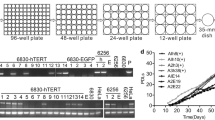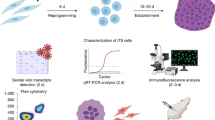Abstract
Fetal fibroblast cells (FFCs) are often used as donor cells for somatic cell nuclear transfer (SCNT) because they are easy to culture and suitable for genetic manipulation. However, through genetic modification process, which required FFCs to be cultured in vitro for several passages, cells tended to age very rapidly and became inappropriate for SCNT. Human telomerase reverse transcriptase (hTERT) possessed the activity of human telomerase and maintains telomere in dividing cells; therefore, hTERT can be transfected into somatic cells to extend their lifespan. In this study, we transfected a Xinong Saanen Dairy Goat FFC line with hTERT. Then, we tested several characteristics of transfected cells, including growth curve, expression and activity of hTERT, tumorigenicity, and expression of oct4 and nanog. The result showed that hTERT could significantly extend the lifespan of transfected cells in vitro. hTERT mRNA was expressed in hTERT-transfected cells. Moreover, hTERT-transfected cells presented enhanced telomerase activity and longer telomere than untransfected cells at the same passage. On the other hand, hTERT-transfected cells can maintain normal karyotype even after several times of subculture in vitro. After inoculation of hTERT-transfected cells in nude mouse, none of them developed tumors on the vaccination site. Interestingly, transfection of hTERT can improve expression of nanog and oct4 in Xinong Saanen Dairy Goat FFCs, especially in low generation after transfection, but with increasing subculture, this effect gradually weakened.




Similar content being viewed by others
References
Boukamp P. Ageing mechanisms: the role of telomere loss. Clin Exp Dermatol 26(7): 562–565; 2001.
Bryan T. M.; Reddel R. R. Telomere dynamics and telomerase activity in in vitro immortalised human cells. Eur. J. Canc. 33(5): 767–773; 1997.
Cawthon R. M. Telomere measurement by quantitative PCR. Nucleic Acids Res 30(10): e47; 2002.
Cawthon R. M. Telomere length measurement by a novel monochrome multiplex quantitative PCR method. Nucleic Acids Res 37(3): e21; 2009.
Clark A. J.; Burl S.; Denning C.; Dickinson P. Gene targeting in livestock: a preview. Transgenic Res 9(4–5): 263–275; 2000.
Dickson M. A.; Hahn W. C.; Ino Y.; Ronfard V.; Wu J. Y.; Weinberg R. A.; Louis D. N.; Li F. P.; Rheinwald J. G. Human keratinocytes that express hTERT and also bypass a p16(INK4a)-enforced mechanism that limits life span become immortal yet retain normal growth and differentiation characteristics. Methods in Cell Biology 20(4): 1436–1447; 2000.
Flores I.; Cayuela M. L.; Blasco M. A. Effects of telomerase and telomere length on epidermal stem cell behavior. Science 309(5738): 1253–1256; 2005.
Gordon K. E.; Parkinson E. K. Analysis of telomerase activity and telomere function in cancer. Methods Mol Biol 281: 333–348; 2004.
Guilleret I.; Yan P.; Grange F.; Braunschweig R.; Bosman F. T.; Benhattar J. Hypermethylation of the human telomerase catalytic subunit (hTERT) gene correlates with telomerase activity. Int J Canc 101(4): 335–341; 2002.
Hewakapuge S.; van Oorschot R. A.; Lewandowski P.; Baindur-Hudson S. Investigation of telomere lengths measurement by quantitative real-time PCR to predict age. Leg Med (Tokyo) 10(5): 236–242; 2008.
Illeperuma R. P.; Park Y. J.; Kim J. M.; Bae J. Y.; Che Z. M.; Son H. K.; Han M. R.; Kim K. M.; Kim J. Immortalized gingival fibroblasts as a cytotoxicity test model for dental materials. J Mater Sci Mater Med 23(3): 753–762; 2012.
Jiang H.; Ju Z.; Rudolph K. L. Telomere shortening and ageing. Zeitschrift Fur Gerontologie Und Geriatrie 40(5): 314–324; 2007.
Ke M.; Hsu J.; Jiang Y.; Cheng W.; Ju Y. Characterization of hTERT-immortalized caprine mammary epithelial cells. Reprod. Domest. Anim 47(4): 553–561; 2012.
Kim J.; Ji M.; DiDonato J. A.; Rackley R. R.; Kuang M.; Sadhukhan P. C.; Mauney J. R.; Keay S. K.; Freeman M. R.; Liou L. S.; Adam R. M. An hTERT-immortalized human urothelial cell line that responds to anti-proliferative factor. Vitro Cell Dev Biol Anim 47(1): 2–9; 2011a.
Kim S.; Sandler D. P.; Carswell G.; Weinberg C. R.; Taylor J. A. Reliability and short-term intra-individual variability of telomere length measurement using monochrome multiplexing quantitative PCR. Plos One 6(9): e25774; 2011b.
Kiyono T.; Foster S. A.; Koop J. I.; McDougall J. K.; Galloway D. A.; Klingelhutz A. J. Both Rb/p16INK4a inactivation and telomerase activity are required to immortalize human epithelial cells. Nature 396: 84–88; 1998.
Kormann-Bortolotto M. H.; Borsatto B.; Smith M. Telomere shortening, ageing, and chromosome damage. Mech Ageing Dev 89(1): 45–49; 1996.
Kyo S.; Kanaya T.; Takakura M.; Tanaka M.; Inoue M. Human telomerase reverse transcriptase as a critical determinant of telomerase activity in normal and malignant endometrial tissues. Int J Canc 80(1): 60–63; 1999.
Lan G. C.; Chang Z. L.; Luo M. J.; Jiang Y. L.; Han D.; Wu Y. G.; Han Z. B.; Ma S. F.; Tan J. H. Production of cloned goats by nuclear transfer of cumulus cells and long-term cultured fetal fibroblast cells into abattoir-derived oocytes. Mol Reprod Dev 73(7): 834–840; 2006.
Li X.; Qu Y.; Mao M.; Yu F.; Li Q.; Hua Y.; Mu D. Expression of human telomerase reverse transcriptase in bone marrow CD34+ cells from patients with beta-thalassemia major. Transfusion 48(8): 1627–1633; 2008.
Li X. H.; Tremoleda J. L.; Allen W. R. Effect of the number of passages of fetal and adult fibroblasts on nuclear remodelling and first embryonic division in reconstructed horse oocytes after nuclear transfer. Reproduction 125(4): 535–542; 2003.
Murata K.; Hanzawa K.; Kasai F.; Takeuchi M.; Echigoya T.; Yasumoto S. Robertsonian translocation as a result of telomere shortening during replicative senescence and immortalization of bovine oviduct epithelial cells. Vitro Cell Dev Biol Anim 43(7): 235–244; 2007.
Polanska U. M.; Acar A. & Orimo A. Experimental generation of carcinoma-associated fibroblasts (CAFs) from human mammary fibroblasts. J Vis Exp (56): e3201; 2011.
Price D. K.; Figg W. D. hTert-immortalized endothelial cells: an important new research tool. Cell Cycle 3(6): 789; 2004.
Roh S.; Shim H.; Hwang W. S.; Yoon J. T. In vitro development of green fluorescent protein (GFP) transgenic bovine embryos after nuclear transfer using different cell cycles and passages of fetal fibroblasts. Reprod Fertil Dev 12(1–2): 1–6; 2000.
Schaetzlein S.; Rudolph K. L. Telomere length regulation during cloning, embryogenesis and ageing. Reprod Fertil Dev 17(1–2): 85–96; 2005.
Shay J. W.; Wright W. E. Senescence and immortalization: role of telomeres and telomerase. Carcinogenesis 26(5): 867–874; 2005.
Thomson A. J.; Marques M. M.; McWhir J. Gene targeting in livestock. Reprod Suppl 61: 495–508; 2003.
Veitonmaki N.; Fuxe J.; Hultdin M.; Roos G.; Pettersson R. F.; Cao Y. Immortalization of bovine capillary endothelial cells by hTERT alone involves inactivation of endogenous p16INK4A/pRb. Faseb J 17(6): 764–766; 2003.
Xiang H.; Wang J.; Mao Y. W.; Li D. W. C. hTERT can function with rabbit telomerase RNA: regulation of gene expression and attenuation of apoptosis. Biochem Biophys Res Comm 278(3): 503–510; 2000.
Yamaguchi S.; Kimura H.; Tada M.; Nakatsuji N.; Tada T. Nanog expression in mouse germ cell development. Gene Expression Patterns 5(5): 639–646; 2005.
Acknowledgments
We thank Professor Yaping Jin for providing the plasmid and Dr. Yajun Liu and Xiaojun Qu for their technical help. This study was supported by funds from the National Science and Technology Major Project of China (no. 2009ZX08008-010B) and State Key Laboratory of Veterinary Etiological Biology (SKLVE2009KFKT001).
Author information
Authors and Affiliations
Corresponding author
Additional information
Editor: T. Okamoto
Electronic supplementary material
Below is the link to the electronic supplementary material.

Fig. 1
Untransfected fibroblast at passage 30. Cells begin to deform, grow slowly, and exhibit senescence characteristics (JPEG 360 kb)

Fig. 2
Karyotype and tumorigenicity of hTERT fibroblast. a Karyotype was tested at 50th passage; b1 nude mouse 6 wk after inoculation of hTERT fibroblast at passage10; b2 nude mouse 6 wk after inoculation of hTERT fibroblast at passage30; b3 nude mouse 6 wk after inoculation of hTERT fibroblast at passage50; b4 nude mouse 6 wk after inoculation of Hela cells (JPEG 227 kb)
Rights and permissions
About this article
Cite this article
Xie, Y., Zhao, X., Jia, H. et al. Derivation and characterization of goat fetal fibroblast cells induced with human telomerase reverse transcriptase. In Vitro Cell.Dev.Biol.-Animal 49, 8–14 (2013). https://doi.org/10.1007/s11626-012-9554-4
Received:
Accepted:
Published:
Issue Date:
DOI: https://doi.org/10.1007/s11626-012-9554-4




